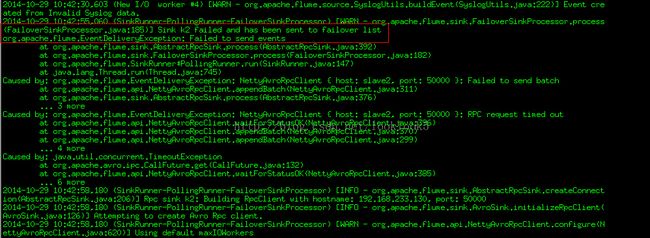Flume NG 学习笔记(七)Sink Processors(故障转移与负载均衡)测试
Sink groups允许组织多个sink到一个实体上。 Sink processors能够提供在组内所有Sink之间实现负载均衡的能力,而且在失败的情况下能够进行故障转移从一个Sink到另一个Sink。
简单的说就是一个source 对应一个Sinkgroups,即多个sink,这里实际上与第六节的复用/复制情况差不多,只是这里考虑的是可靠性与性能,即故障转移与负载均衡的设置。
下面是官方配置:
| Property Name |
Default |
Description |
| sinks |
– |
Space-separated list of sinks that are participating in the group |
| processor.type |
default |
The component type name, needs to be default, failover or load_balance |
从参数类型上可以看出有3种Processors类型:default, failover(故障转移)和 load_balance(负载均衡),当然,官网上说目前自定义processors 还不支持。
下面是官网例子
a1.sinkgroups=g1
a1.sinkgroups.g1.sinks=k1 k2
a1.sinkgroups.g1.processor.type=load_balance
一、Default Sink Processor
DefaultSink Processor 接收单一的Sink,不强制用户为Sink创建Processor,前面举了很多例子。所以这个就不多说了。
二、Failover Sink Processor(故障转移)
FailoverSink Processor会通过配置维护了一个优先级列表。保证每一个有效的事件都会被处理。
故障转移的工作原理是将连续失败sink分配到一个池中,在那里被分配一个冷冻期,在这个冷冻期里,这个sink不会做任何事。一旦sink成功发送一个event,sink将被还原到live 池中。
在这配置中,要设置sinkgroups processor为failover,需要为所有的sink分配优先级,所有的优先级数字必须是唯一的,这个得格外注意。此外,failover time的上限可以通过maxpenalty 属性来进行设置。
下面是官网配置:
| Property Name |
Default |
Description |
| sinks |
– |
Space-separated list of sinks that are participating in the group |
| processor.type |
default |
The component type name, needs to be failover |
| processor.priority. |
– |
|
| processor.maxpenalty |
30000 |
(in millis) |
下面是官网例子
a1.sinkgroups=g1
a1.sinkgroups.g1.sinks=k1 k2
a1.sinkgroups.g1.processor.type=failover
a1.sinkgroups.g1.processor.priority.k1=5
a1.sinkgroups.g1.processor.priority.k2=10
a1.sinkgroups.g1.processor.maxpenalty=10000
这里首先要申明一个sinkgroups,然后再设置2个sink ,k1与k2,其中2个优先级是5和10,而processor的maxpenalty被设置为10秒,默认是30秒。‘
下面是测试例子
#配置文件:failover_sink_case13.conf
#Name the components on this agent
a1.sources= r1
a1.sinks= k1 k2
a1.channels= c1 c2
a1.sinkgroups= g1
a1.sinkgroups.g1.sinks= k1 k2
a1.sinkgroups.g1.processor.type= failover
a1.sinkgroups.g1.processor.priority.k1= 5
a1.sinkgroups.g1.processor.priority.k2= 10
a1.sinkgroups.g1.processor.maxpenalty= 10000
#Describe/configure the source
a1.sources.r1.type= syslogtcp
a1.sources.r1.port= 50000
a1.sources.r1.host= 192.168.233.128
a1.sources.r1.channels= c1 c2
#Describe the sink
a1.sinks.k1.type= avro
a1.sinks.k1.channel= c1
a1.sinks.k1.hostname= 192.168.233.129
a1.sinks.k1.port= 50000
a1.sinks.k2.type= avro
a1.sinks.k2.channel= c2
a1.sinks.k2.hostname= 192.168.233.130
a1.sinks.k2.port= 50000
# Usea channel which buffers events in memory
a1.channels.c1.type= memory
a1.channels.c1.capacity= 1000
a1.channels.c1.transactionCapacity= 100这里设置了2个channels与2个sinks ,关于故障转移的设置直接复制官网的例子。我们还要配置2个sinks对于的代理。这里的2个接受代理我们沿用之前第六章复制的2个sink代理配置。
下面是第一个接受复制事件代理配置
#配置文件:replicate_sink1_case11.conf
# Name the components on this agent
a2.sources = r1
a2.sinks = k1
a2.channels = c1
# Describe/configure the source
a2.sources.r1.type = avro
a2.sources.r1.channels = c1
a2.sources.r1.bind = 192.168.233.129
a2.sources.r1.port = 50000
# Describe the sink
a2.sinks.k1.type = logger
a2.sinks.k1.channel = c1
# Use a channel which buffers events inmemory
a2.channels.c1.type = memory
a2.channels.c1.capacity = 1000
a2.channels.c1.transactionCapacity = 100下面是第二个接受复制事件代理配置:
#配置文件:replicate_sink2_case11.conf
# Name the components on this agent
a3.sources = r1
a3.sinks = k1
a3.channels = c1
# Describe/configure the source
a3.sources.r1.type = avro
a3.sources.r1.channels = c1
a3.sources.r1.bind = 192.168.233.130
a3.sources.r1.port = 50000
# Describe the sink
a3.sinks.k1.type = logger
a3.sinks.k1.channel = c1
# Use a channel which buffers events inmemory
a3.channels.c1.type = memory
a3.channels.c1.capacity = 1000
a3.channels.c1.transactionCapacity = 100#敲命令
首先先启动2个接受复制事件代理,如果先启动源发送的代理,会报他找不到sinks的绑定,因为2个接事件的代理还未起来。
flume-ng agent -cconf -f conf/replicate_sink1_case11.conf -n a1 -Dflume.root.logger=INFO,console
flume-ng agent -cconf -f conf/replicate_sink2_case11.conf -n a1 -Dflume.root.logger=INFO,console
在启动源发送的代理
flume-ng agent -cconf -f conf/failover_sink_case13.conf -n a1 -Dflume.root.logger=INFO,console
启动成功后
打开另一个终端输入,往侦听端口送数据
echo "hello failoversink" | nc 192.168.233.128 50000
#在启动源发送的代理终端查看console输出
因为k1的优先级是5,K2是10因此当K2正常运行的时候,是发送到K2的。下面数据正常输出。
然后我们中断K2的代理进程。
再尝试往侦听端口送数据
echo "hello close k2"| nc 192.168.233.128 50000
我们发现源代理发生事件到K2失败,然后他将K2放入到failover list(故障列表)

因为K1还是正常运行的,因此这个时候他会接收到数据。

然后我们再打开K2的大理进程,我们继续往侦听端口送数据
echo " hello open k2 again" | nc192.168.233.128 50000

数据正常发生,Failover SinkProcessor测试完毕。
三、Load balancing SinkProcessor
负载均衡片处理器提供在多个Sink之间负载平衡的能力。实现支持通过round_robin(轮询)或者random(随机)参数来实现负载分发,默认情况下使用round_robin,但可以通过配置覆盖这个默认值。还可以通过集成AbstractSinkSelector类来实现用户自己的选择机制。
当被调用的时候,这选择器通过配置的选择规则选择下一个sink来调用。
下面是官网配置
| Property Name |
Default |
Description |
| processor.sinks |
– |
Space-separated list of sinks that are participating in the group |
| processor.type |
default |
The component type name, needs to be load_balance |
| processor.backoff |
false |
Should failed sinks be backed off exponentially. |
| processor.selector |
round_robin |
Selection mechanism. Must be either round_robin, random or FQCN of custom class that inherits from AbstractSinkSelector |
| processor.selector.maxTimeOut |
30000 |
Used by backoff selectors to limit exponential backoff (in milliseconds) |
下面是官网的例子
a1.sinkgroups=g1
a1.sinkgroups.g1.sinks=k1 k2
a1.sinkgroups.g1.processor.type=load_balance
a1.sinkgroups.g1.processor.backoff=true
a1.sinkgroups.g1.processor.selector=random
这个与故障转移的设置差不多。
下面是测试例子
#配置文件:load_sink_case14.conf
# Name the components on this agent
a1.sources = r1
a1.sinks = k1 k2
a1.channels = c1
a1.sinkgroups = g1
a1.sinkgroups.g1.sinks = k1 k2
a1.sinkgroups.g1.processor.type =load_balance
a1.sinkgroups.g1.processor.backoff = true
a1.sinkgroups.g1.processor.selector =round_robin
# Describe/configure the source
a1.sources.r1.type = syslogtcp
a1.sources.r1.port = 50000
a1.sources.r1.host = 192.168.233.128
a1.sources.r1.channels = c1
# Describe the sink
a1.sinks.k1.type = avro
a1.sinks.k1.channel = c1
a1.sinks.k1.hostname = 192.168.233.129
a1.sinks.k1.port = 50000
a1.sinks.k2.type = avro
a1.sinks.k2.channel = c1
a1.sinks.k2.hostname = 192.168.233.130
a1.sinks.k2.port = 50000
# Use a channel which buffers events inmemory
a1.channels.c1.type = memory
a1.channels.c1.capacity = 1000
a1.channels.c1.transactionCapacity = 100这里要说明的是,因此测试的是负载均衡的例子,因此这边使用一个channel来作为数据传输通道。这里sinks的对应的接收数据的代理配置,我们沿用故障转移的接收代理配置。
#敲命令
首先先启动2个接受复制事件代理,如果先启动源发送的代理,会报他找不到sinks的绑定,因为2个接事件的代理还未起来。
flume-ng agent -cconf -f conf/replicate_sink1_case11.conf -n a1
-Dflume.root.logger=INFO,console
flume-ng agent -cconf -f conf/replicate_sink2_case11.conf -n a1
-Dflume.root.logger=INFO,console
在启动源发送的代理
flume-ng agent -cconf -f conf/load_sink_case14.conf -n a1
-Dflume.root.logger=INFO,console
启动成功后
打开另一个终端输入,往侦听端口送数据
echo "loadbanlancetest1" | nc 192.168.233.128 50000
echo "loadbantest2" | nc 192.168.233.128 50000
echo "loadban test3"| nc 192.168.233.128 50000
echo "loadbantest4" | nc 192.168.233.128 50000
echo "loadbantest5" | nc 192.168.233.128 50000
#在启动源发送的代理终端查看console输出
其中K1收到3条数据

其中K1收到2条数据

因为我们负载均衡选择的类型是轮询,因此可以看出flume 让代理每次向一个sink发送2次事件数据后就换另一个sinks 发送。
Sink Processors测试完毕
